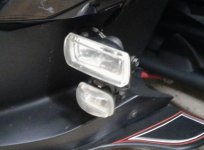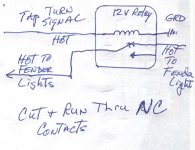JerryB
New member
Hi folks,
I am going to be doing some new wiring on my Spyder and have been looking for Normally Closed Relays.
I usually buy my relays from Eastern Beaver because he sells good stuff:
https://www.easternbeaver.com/Main/main.html
However, he does not carry a Normally Closed Relay.
After a lot of time on the 'net, lots of emails, too many phone calls, I found this:
https://www.alliedelec.com/schneider-electric-magnecraft-92s11d22d-12/70185037/
And what is even better is that it can control two lights separately.
Now, I have not yet gotten this little guy here to actually try/use; I'll try to keep you posted on how it works.
Just some info for those nutty DIY'ers like me,
Jerry Baumchen
Ps: Here is a sketch of what I am trying to do:

I am going to be doing some new wiring on my Spyder and have been looking for Normally Closed Relays.
I usually buy my relays from Eastern Beaver because he sells good stuff:
https://www.easternbeaver.com/Main/main.html
However, he does not carry a Normally Closed Relay.
After a lot of time on the 'net, lots of emails, too many phone calls, I found this:
https://www.alliedelec.com/schneider-electric-magnecraft-92s11d22d-12/70185037/
And what is even better is that it can control two lights separately.
Now, I have not yet gotten this little guy here to actually try/use; I'll try to keep you posted on how it works.
Just some info for those nutty DIY'ers like me,
Jerry Baumchen
Ps: Here is a sketch of what I am trying to do:



